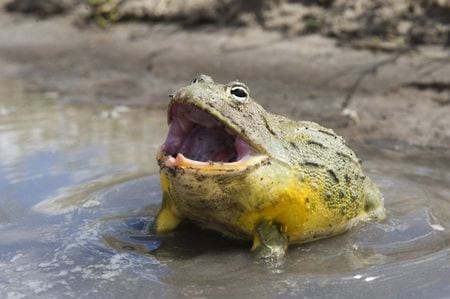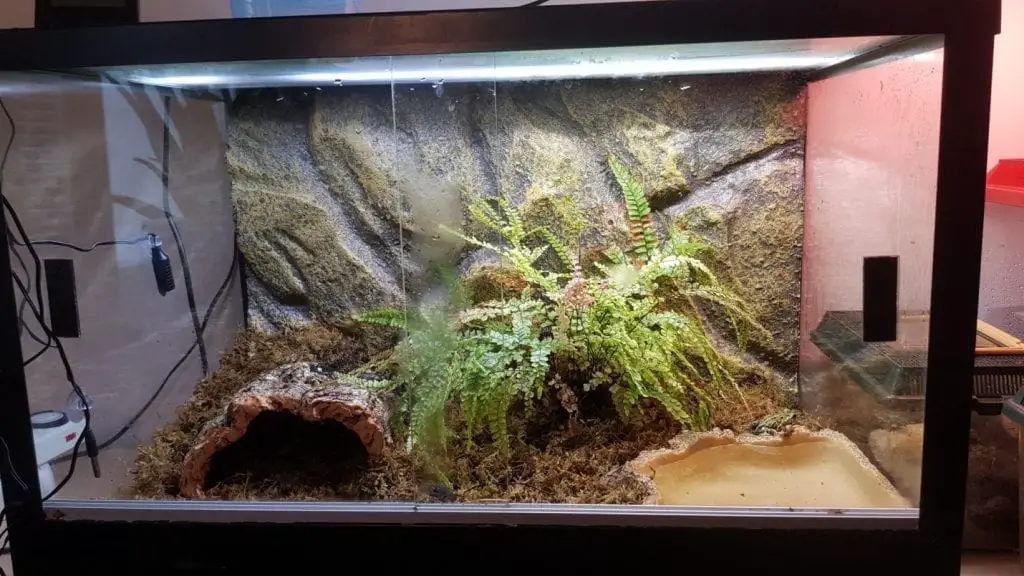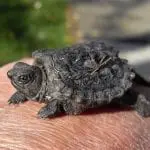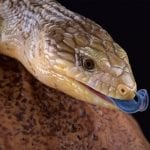Scientific Facts
| Common Name: | African Bullfrog |
| Scientific Name: | Pyxicephalus adspersus |
| Life Span: | 20 to 50 years |
| Size: | Up to 9 inches and 4.4 lbs |
| Habitat: | Savannas and swamps |
| Country of Origin: | African countries |
Physical Description

African Bullfrogs are characterized as being large types of frogs that can reach lengths of nine inches and weights of more than 4 lbs. Most African Bullfrogs have bodies that are olive green in color. Meanwhile, their bellies tend to be a lighter shade of green or somewhere close to yellow. They also have ridges on their dorsal surface.
The legs of an African Bullfrog appear to be thick. The toes on the front legs are big and have no webbing. Meanwhile, their hind feet have webbing. But what really stands out about their hind legs are the spade-like calluses on the inner toes. Such a characteristic allows them to dig easier than most other frog species.
There are different physical characteristics of male and female African Bullfrogs. For one, males tend to be a lot bigger and heavier than the smaller females, who are only about half the size of a common male. The males are mostly olive green and have throats that can be orange or yellowish in color. Meanwhile, the females are also mostly olive green but there are some that are closer to light brown. Juvenile African Bullfrogs may also have a different appearance compared to adults. They usually are more colorful than adults and have a yellow dorsal stripe. However, in some cases, females may retain that dorsal stripe.
African Bullfrogs have really large and heavy heads thanks to how their huge skulls. Meanwhile, their bottom jaws have three huge teeth-like structures that allow them to cling on struggling prey trying to escape them.
One of the defense mechanisms of African Bullfrogs is their poison. They do not excrete poison but their bodies do contain a poisonous substance that can potentially cause kidney failure. As such, predators naturally try to stay away from them. And when the predator is brave enough to try to attack an African Bullfrog, this amphibian can inflate itself like a balloon to make its self look big and to discourage an aggressor from trying to eat it.
Lifespan
African Bullfrogs are very hardy and resilient amphibians that have a long lifespan. It is very common for an ordinary African Bullfrog to reach 20 to 30 years. However, there have been cases where these amphibians were able to exceed 40 years. There actually was a reported case of an African Bullfrog living past 51 years old.
It will take a few years for an African Bullfrog to reach its mature size. They usually stay as tadpoles for about a 1 year and a half to 3 years. After that, they actually reach sexual maturity but not their mature size. It may take a few more years for them to reach their full size as African Bullfrogs tend to grow at a steady and a somewhat slow pace due to their long lifespan. Nevertheless, they are already sexually mature by the time they reach 2 to 3 years old and will be ready for mating.
Eating Habits
There is no other way to say it but African Bullfrogs are extreme gluttons when it comes to food. A simple search on the internet will show you plenty of things about the eating habits of these huge frogs. They will consume anything and everything they can fit in their mouths so long as it is live prey. In that sense, there are plenty of stories and videos that document the awesome and intense eating habits of the large African Bullfrog.
African Bullfrogs are carnivorous amphibians that will eat any prey in sight so long as they are small enough to fit the gigantic mouths of these ferocious and active eaters. These amphibians have a seemingly insatiable hunger and will eat anything they see. So, if you offer them a lot of live prey, they will most likely gobble them up in minutes before you know it.
A typical adult African Bullfrog’s diet is so diverse because these frogs will eat anything so long as the prey can fit in their mouth and so long as they can overpower them. The most common staple parts of their regular diet are insects such as crickets, cockroaches, grasshoppers, or other types of invertebrates that are small enough to be eaten by these amphibians in just a matter of seconds. As a matter of fact, African Bullfrogs are not picky eaters.
Again, so long as the prey can fit, they will eat it. In that case, it is common for them to eat different types of mammals and birds live. Mice are a staple part of their diet as well and they can easily eat an entire mouse whole without having to break them apart. Birds who venture too close to these frogs can find themselves in the mouth of an African Bullfrog, which is quick to strike on their prey.
There are even cases when these African Bullfrogs would eat other members of their species the moment they metamorphose from tadpoles to frogs. As long as the other African Bullfrog is small enough to fit the mouth of the bigger one, it is potential prey. The same could be said of other species of amphibians and even reptiles. In one story, an African Bullfrog from a zoo once ate 17 baby cobras all by itself in one sitting. Needless to say, African Bullfrogs have an appetite that is simply insatiable and a mouth that can gobble up anything.
In your case, your pet African Bullfrog should best eat a healthy well-balanced diet composed of gut-loaded crickets to counteract the natural phosphorous levels in invertebrates. You can also feed them mice and amphibians from time to time. However, make sure to stay away from commercial meat because African Bullfrogs tend to get more nutrition from live prey.
Sleeping Habits
African Bullfrogs, like many other types of bullfrogs, are rare creatures in the sense that they do not sleep in a way that fits the typical definition of what is sleep. That means that they are always active no matter what time of the day it is. However, they do undergo periods of rest that is not necessarily sleeping or naps but are merely moments when their bodily functions are not as active as they are during any other time of the day. That said, the African Bullfrog is one of the few rare creatures that do not require sleep.
Water
African Bullfrogs can normally be found in places where water is not scarce. They love staying near the water and need lots of water to keep their large bodies hydrated. In that sense, you better offer them a large water dish they can drink from and also use for soaking. You might also want to dampen the enclosure by regularly misting it. However, also make sure that the enclosure does not get flooded. Just see to it that the substrate does not dry up. You should also keep an eye on the water because contaminated water can be an overnight killer for a healthy and thriving African Bullfrog.
Development and Reproduction
African Bullfrogs will stay as tadpoles for the first few months of their lives or even for up to a year and a half until they steadily undergo metamorphosis into frogs. These frogs will need about 1 year and a half to 3 years to reach sexual maturity. It is easy to tell the males from the females apart just by looking at the size difference. The males are more likely twice the size of a female. But, if you still cannot tell them apart, males have throats that are yellowish while females usually have throats that are closer to cream in terms of color.
How to Breed
Breeding season in African Bullfrogs usually occurs after heavy rain, which is defined as rainfall that can reach 2.6 inches in the course of maybe a day or two. When that happens, these amphibians will be induced to reproduce.
During the mating season, several different males will start to call out for mates. After that, they will congregate in a large group where the small and younger males group together while the larger older males stand in the center to show off their dominance. Aggression is common during congregation as males fight for dominance over other males. You will see pushing, biting, or even eating as there will be males big enough to eat other smaller males. This is nothing short of brutal.
The females will hear the call of a dominant male and will start to swim towards the larger and stronger ones while avoiding smaller and weaker males. Males will start to persuade the females to mate with them until they give in to the sexual advances. After mating, females can produce and lay as many as 4,000 eggs.
A unique characteristic of the male African Bullfrog is that it actually shows parental care in the sense that it will take care of the eggs until they hatch. When the eggs hatch, the males will still look over the tadpoles, who are also quite carnivorous in the sense that they will feed on their fellow tadpoles and on smaller fish. In some cases, however, the males may eat on their own offspring while keeping guard.
Common Health Problems
African Bullfrogs are resilient, hardy, and generally healthy amphibians that can live a long time both in captivity and in the wild. However, that does not mean that they are not susceptible to common illnesses. Here are some health problems you should know when it comes to these frogs:
Obesity
African Bullfrogs are gluttons. These mammoth frogs will eat anything in sight so long as the prey can fit in their large mouths. They do not know when to stop eating especially when their prey is right before their eyes. That means that they are very susceptible to obesity and will quickly become too big for their bodies to handle. There are plenty of other illnesses that accompany obesity, so you better make sure to keep an eye on your African Bullfrog’s diet.
Metabolic bone disease
Metabolic bone disease is pretty common in amphibians and reptiles who often love feasting on insects that are high in phosphorous. This disease is usually the result of low calcium to phosphorous ratio. So if your African Bullfrog does not get ample ultraviolet B lights for calcium and vitamin D3 absorption or if it isn’t eating gut-loaded invertebrates that were fed with high-calcium food, then there is a chance that your frog will end up with this disease. Signs of the metabolic bone disease include deformity, weak limbs and bones, and fractured bones.
Bacterial and fungal infections
Bacterial and fungal infections are common in African Bullfrogs that live in conditions that are not suitable for their kind. You will often see these types of infections manifesting in their skin and large mouths their eyes. So, if you do not house them in an environment that has the warmth and the humidity they need to live well, then your African Bullfrog will more than likely suffer bacterial and fungal infections.
Preventing Illness
It can be quite easy to prevent diseases and illnesses in your African Bullfrog so long as you know the root causes of such problems. For one, diet is essential in preventing obesity and other nutrition-related illnesses. Make sure that you do not only feed them the right amount of food but also the right type while supplementing their regular diet of insects and small mammals with calcium and vitamin D3. Of course, it is important to give them the right living conditions in terms of warmth, humidity, and hygiene if you want to avoid bacterial infections of any kind.
Going to a vet should be your best course of action if your African Bullfrog, which is normally an insatiable eater, refuses to eat or if it looks lethargic. Look for a vet that specializes in handling reptiles, amphibians, and other exotic pets to avoid a wrong diagnosis that could potentially lead to the death of your African Bullfrog.
Behavior
The African Bullfrog is one of the few species of ridged-skin frogs that can be handled because they are not overly aggressive especially when it comes to species that it cannot eat. However, you should not always handle them because they tend to have sensitive skin and that they tend to bite at times depending on how you handle them. They are generally peaceful animals except when they are eating or fighting for a mate.
That said, here are some of the common things you may notice in your African Bullfrog:
Croaking
There are different reasons why a frog croaks but when an African Bullfrog is croaking while you are handling it, that is a sign that it is stressed. An African Bullfrog under stress can potentially attack you with its large mouth and strong teeth. Listen to when they start croaking so you will know when to put them back in their proper place.
Burrowing
Adult African Bullfrogs love burrowing underground for different reasons. As such, be sure to house them in an enclosure with a substrate they can burrow through. They usually burrow to avoid dehydration. In that regard, also keep an eye on the substrate and always see to it that it stays damp to provide your African Bullfrog with a lot of moisture.
Inflating
There will be cases and moments when your African Bullfrog inflates itself to make it appear like a balloon. This is actually a defense mechanism that allows them to look bigger than they actually are so that they can dissuade any potential predators from eating them.
Hibernation Cycle
As mentioned, African Bullfrogs are one of the few animals that do not sleep. They, in fact, do not even need to sleep at all. In that case, hibernation is completely out of the question for African Bullfrogs. However, the do undergo a period of dormancy that is quite similar to hibernation in the sense that they will not be as active as they usually are. African Bullfrogs may slough off some of their skin’s outer cells to that form a sort of protective cocoon over them. During this time, they will be quite dormant and most of their bodily functions tend to slow down or even shut down. This period might take a few months or potentially a year.
Shedding
As African Bullfrogs grow, they will need to grow a new skin as well to accommodate their growing bodies. That means that they will undergo periodical shedding of the old skin to make way for new skin to grow. The process of shedding in African Bullfrogs is also a way of making sure that their outer layer does not harden enough for oxygen to pass through as it is common for many frogs to breathe through their skin when they are underwater.
While shedding their skin, it is common for them to eat it after they push it away from their entire body using their strong front and hind legs. To make the process of shedding easier, you better keep your African Bullfrog in a humid environment so that its skin stays moist.
Habitat

Frogs are some of the easiest pets to care for and the African Bullfrog is no different as long as you provide it with habitat or an enclosure that is suitable for it to live in. To start, you can choose to house them in a terrarium that is at least 15 gallons. You can safely put them in these small 15-gallon terrariums because African Bullfrogs are not very active in the sense that they need a lot of space for roaming. However, it is still better to go for bigger terrariums that are north of 30 gallons.
African Bullfrogs are not very picky when it comes to choosing a place where they can live safely and happily. They will easily get along in almost any kind of accommodation so long as they can do the things they normally do. In that regard, you do not have to go for the best and biggest terrarium or aquarium because your priority should be the living conditions in their housing or their enclosure.
Try decorating their terrarium with small rocks at the bottom of the tank so that they will have something to climb on to when they want to get out of the water in their housing. You can also decorate the terrarium with plastic plants. A lot of zoos use plastic plants because African Bullfrogs are not choosy when it comes to looking for places to hide. While they are not the strongest jumpers, make sure to keep a tight lid on your aquarium or terrarium to prevent your African Bullfrogs from escaping.
Lighting and Humidity
When it comes to providing your African Bullfrogs with light, these amphibians do not necessarily require ultraviolet B lamps but they can still benefit from them. This is a departure from some reptiles, who need UVB lamps to provide them with calcium and vitamin D3. In the case of your African Bullfrog, the best way to provide them with such vitamins and minerals is through their food. As such, a UVB lamp is not required.
The main purpose of lighting in the African Bullfrog’s enclosure is to provide them with the heat they require to live in suitable habitat. Incandescent bulbs are perfect because these light sources emit just the right amount of heat your frog needs. A radiant heat source may not be the best way to provide them with heat because of how it tends to dry up the substrate and the environment.
Humidity is by far the most important part of setting up your African Bullfrog’s habitat. Always see to it that their enclosure has high humidity levels that are somewhere over 50%. You can keep the humidity levels up by providing the frog with a large water dish they can drink from and swim in. However, the best way to maintain high humidity levels is to regularly mist the enclosure. Try to keep the substrate damp at all times.
Temperature
African Bullfrogs love environments that are warm enough for them. That said, keep temperatures above 75 degrees Fahrenheit at the coolest portion and about 90 degrees in the warmest part of the enclosure. You can use incandescent bulbs to heat the enclosure or you may choose to use a heating pad to increase the temperature. If you want, you may also heat water heaters designed for fish tanks to make the water in the enclosure warm enough for your African Bullfrog.
Sanitation
Keeping the enclosure as clean and as sanitary as impossible can make an entire difference when it comes to your African Bullfrog’s health. For example, an enclosure that has not been cleaned of waste material for a long time tends to build up ammonia. Ammonia poisoning is one of the most common pet killers. In that case, always make sure to clean the enclosure whenever possible to prevent ammonia and other harmful bacteria from building up. Replacing the water in the tank is also a must especially because water is also one of the places where waste matter and bacteria can easily build up.
Natural Environment – Substrate
African Bullfrogs love digging through the substrate to hide and to stay moist and hydrated. That means that you should provide them with a substrate that they can safely dig through. You can use coco fiber or peat moss. Soil is also a good option but be sure to use soil that is free from insecticides, pesticides, or other chemicals because that can potentially be harmful to your pet frog.
Hydration
The best way to keep your African Bullfrog hydrated is to keep a large water dish or tank inside the enclosure. They regularly love to drink water and to soak their entire bodies or even swim in bodies of water. Aside from that, another way to keep your African Bullfrog hydrated is to regularly mist the enclosure with water. This increases the humidity levels and dampens the substrate.
Availability – Where to Get One?
It is fairly easy to find pet stores selling African Bullfrogs because they are common animals in the exotic pet trade. Some of these frogs tend to be wild-caught but the most common ones are bred in captivity. You can go online to find a seller or a breeder near you. Juveniles tend to cost somewhere close to $15 while the larger adults can cost as much as $75.
How to Care for an African Bullfrog?
Here are some tips on how to care for an African Bullfrog:
- You can handle African Bullfrogs as these are some of the rare types of frogs you can handle safely. However, they have sensitive skins that can easily absorb anything so make sure to sanitize yourself before handling one. Also, try to be sensitive with them as they might get stressed when you handle them too much or too roughly.
- Avoid overfeeding them because African Bullfrogs do not know when to stop eating and will end up becoming obese if you are not careful with their diet.
- Try not to house them together with a smaller African Bullfrog because these giants will gobble up anything that is smaller than them.
- Always keep the humidity levels up and make sure to provide them with plenty of water.
FAQs
Do African Bullfrogs sleep?
Bullfrogs are one of the few animals that do not need to sleep. They do have their own versions of sleep but it is not the type of sleep that fits the usual definition of what sleep is.
Do African Bullfrogs hibernate?
African Bullfrogs do not hibernate or even sleep. But they may undergo their own version of hibernation, which are certain extended periods of dormancy wherein some of their bodily functions slow down or even shut down.
What do African Bullfrogs eat?
As long as the prey is smaller and easy to overpower, the African Bullfrog will eat it. In that case, these amphibians will eat anything that fits into their mouths but you still have to make sure that they get a balanced and healthy diet.
How often should I feed my African Bullfrog?
Juvenile African Bullfrogs need to be fed regularly and about 5 to 7 times a week. Meanwhile, adults should be fed 3 to 4 times a week or every other day.
Do African Bullfrogs bite?
African Bullfrogs are not aggressive or defensive towards humans but they will bite you if they are placed under a stressful situation. Their bites are painful because of their large mouths, strong jaws, and sharp teeth.
Can you house African Bullfrogs together?
Generally, an African Bullfrog can live with another adult African Bullfrog in peace in the same enclosure but if the other one is a lot smaller, then there is a danger that the larger one will eat it.
Are African Bullfrogs the largest frogs in the world?
As large as they are, African Bullfrogs are not the largest frogs in the world. That distinction goes to their larger cousins, the African Goliath Frogs.
How long on average does an African Bullfrog live?
Most African Bullfrog can live somewhere between 20 to 30 years but there have been reports of these amphibians living past 50 years.
Are African Bullfrogs reptiles?
Like any frog, the African Bullfrog is not a reptile but an amphibian.
Is it okay to touch an African Bullfrog?
It is okay to touch an African Bullfrog but make sure that your hands are clean because they have extra sensitive skin that easily absorbs bacteria.


